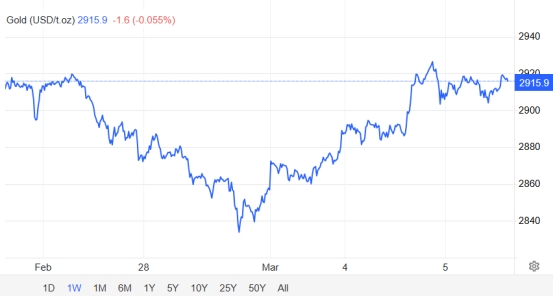Gold prices fluctuate, and major institutions have new views on the gold market
- 2025年3月7日
- Posted by: Macro Global Markets
- Category: News

Gold prices fluctuate, and major institutions have new views on the gold market

Last week, international gold prices experienced a sharp drop. The price of the main gold futures contract on the New York Mercantile Exchange fell by 3.55% in total, ending the previous nine-week rally. This was also the largest single-week drop in international gold prices since November last year. The domestic gold market was also affected, with retail prices of domestic consumer gold jewellery falling across the board.
The main reasons for the plunge are the easing of geopolitical risks, the easing of the situation between Russia and Ukraine, the cooling of the Palestinian-Israeli conflict, and the decline in the market's safe-haven demand for gold; the hawkish signal from the Federal Reserve, which emphasized maintaining an interest rate range of 4.25%-4.5% to combat inflation, and the increased opportunity cost of holding gold in a high-interest rate environment; investors taking profits, as gold prices had continued to rise and a large amount of profit-taking had accumulated. Investors cashing in their profits triggered a market sell-off; and the replenishment of COMEX gold inventories and the reduction of short-term premium factors.
Gold prices retreated to above $2,900 this week
On March 4 this week, spot gold broke through $2,920 per ounce, rising for two consecutive days. The retail prices of gold in domestic branded gold shops also generally rose.
The reasons for the pullback include rising risk aversion sentiment. Market concerns that the Trump administration may take additional measures against gold in its comprehensive tariff plan have prompted U.S. financial institutions and investors to buy gold in large quantities; global central banks' demand for gold purchases. Global central banks continue to increase their gold reserves, providing long-term support for gold prices; and a technical rebound. After gold prices fell sharply last week, there was strong demand for a technical rebound.
New views of major institutions on the gold market
JPMorgan Chase predicts that gold prices could approach $3,000 an ounce by the fourth quarter of 2025, believing that demand for gold will continue to exist as a hedge against inflation, geopolitical uncertainty and potential changes in global monetary policy.
Goldman Sachs said that gold will be an effective tool to hedge against tariff and inflation risks due to strong demand from central banks, and its price may rise by 8% this year, and it is expected to reach $3,100 an ounce by the end of the year. If economic policy uncertainty persists, particularly concerns about tariffs, gold prices could rise further to $3,300 an ounce.
Industrial Bank Research pointed out that the rapid rise in gold prices in the short term has accumulated a lot of profit-taking. If the Ukrainian crisis ends, it may have a negative impact on gold prices, but in the long run, the allocation value of gold is still significant.
Conclusion
In the coming months, the market will focus on core risk events such as the US non-farm payrolls data, the ECB's interest rate decision, Canadian employment data, and the Reserve Bank of Australia's meeting minutes. Although gold prices are facing adjustment pressure in the short term, in the medium and long term, the allocation value of gold remains significant. In the current market environment, investors should pay attention to current events and other data that affect the direction of gold, while being alert to short-term volatility risks and making reasonable judgments.

Transaction risk warning: Any investment involves risks, including the risk of financial loss. This advice does not constitute specific investment advice and investors should make decisions based on their own risk tolerance, investment objectives and market conditions.
